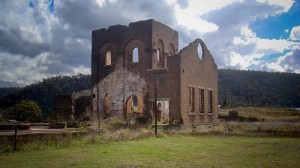Day 22 – 9,708 KM. Town 38.
I arrived late into Lithgow following my journey from Molong but was pleased to learn more about this town and why it uses the “Big Miners Lamp” (see above) as its tourist information office.
Lithgow is at the heart of a coal mining district and there are two coal-powered power stations nearby utilising this resource (one the largest in New South Wales). Indeed, steam/smoke can be seen for miles surrounding Lithgow Valley, so named by John Oxley in honour of William Lithgow, the first Auditor-General of New South Wales.
Lithgow is also home to around 20,000 people as well as the now disused site of Australia’s first commercially-viable steel mill. The ruins are now open for inspection at “Blast Furnace Park”.
Perhaps more interesting though was a throwaway line I read whilst researching what to see in Lithgow on Wikipedia “Lithgow was also the location of an alleged assassination attempt on the life of Queen Elizabeth II in 1970“.
This news story broke in January 2009 when a retired Detective Superintendent Cliff McHardy aged 81 decided to spill the beans on this alleged assassination attempt. Apparently he claimed that unidentified conspirators put a wooden log on a railway track to try to derail the official train transporting the Queen and Duke of Edinburgh from Sydney across Australia’s Great Dividing Range of mountains.
According to an article in the UK Daily Telegraph, “On April 29, 1970, the Queen and Duke were travelling by train to the farming town of Orange. When the train entered a winding cutting near the Blue Mountains town of Lithgow, two hours to the west of Sydney, it struck a large log wedged across the rails. Mr McHardy insists that it was an act of deliberate sabotage to force the train off the tracks.
The retired police officer said that “catastrophe” was only averted because the train driver was travelling unusually slowly. “If the train had reached its normal speed it would have plunged off the tracks and into an embankment,” he said. But, instead, the log became stuck underneath the front wheels for 200 metres before the train, largely undamaged, came to a halt at a level crossing.”
Now this is strange on two counts, firstly I would have thought something like this would have been big news, which indeed it may have been, only I certainly missed it. And secondly, the inspector advises that if the train had been going at its usual speed disaster would have been more likely. I can only assume the inspector does not use NSW trains frequently as speed is not an adjective that is ever used to describe their snails pace motion.
(On a side note, the Sydney suburb of Clontarf was the location for an unsuccessful assassination attempt on Queen Victoria’s son, Alfred on 12 March 1868).
Again the rain is to blame for me seeing so little of what Lithgow has to offer. I hope to return one day to take in the famous Zig Zag Railway and also the Glow Worm tunnel but until then, I leave for my next destination, Megalong.

